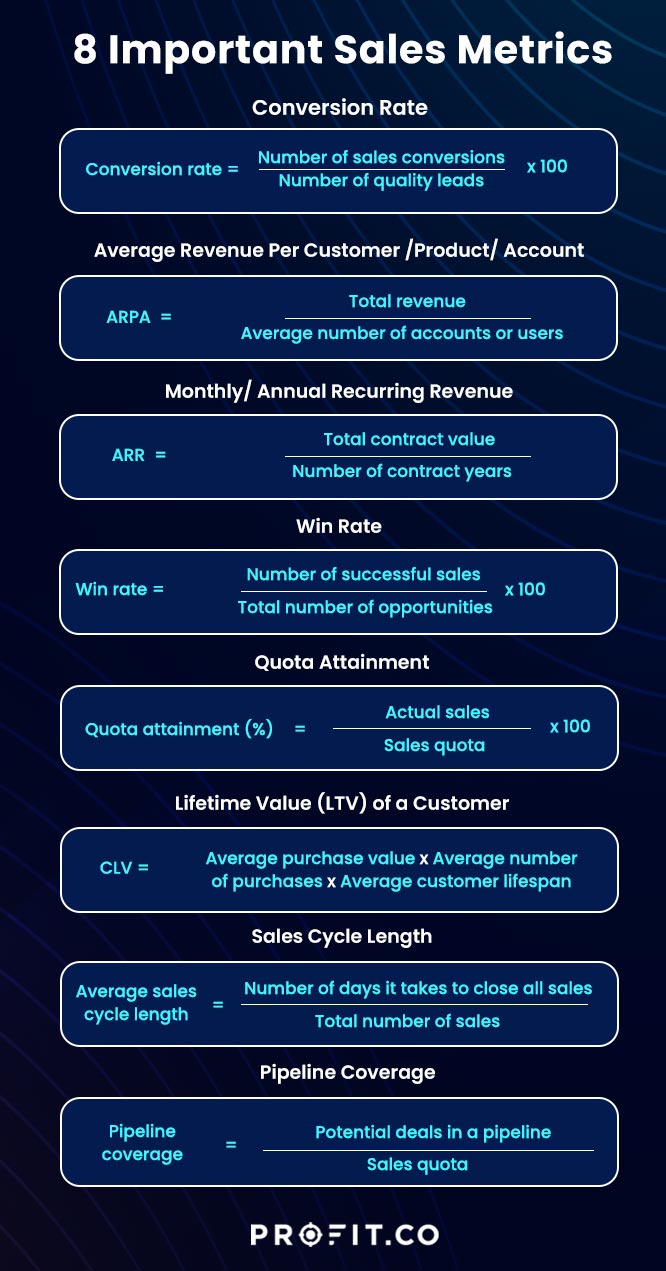Are you curious about how to measure and track the success of your sales operations? Do you want to understand your customers, optimize your sales process and make informed decisions?
Well, you are in the right place!
This article explores what sales metrics are, why they are important, different types of sales metrics, and the eight essential ones for any business. Let’s dive in, shall we?
What are Sales Metrics?
Sales metrics involve collecting data points, analyzing them, and using formulas to measure how effective a business’s sales strategy is.
These metrics help you understand what works best regarding marketing efforts, pricing strategies, customer segmentation, and more. You can make informed decisions leading to increased revenue and improved sales team efficiency.
Definition
Sales metrics are a set of measurements used to track the performance of sales operations. These data points give insight into your strategies’ effectiveness at generating leads, converting customers, and increasing revenue.
How Are They Different from Sales KPIs
Sales metrics and KPIs are two related yet distinct concepts when measuring the performance of a business’s sales operations.
Sales metrics provide an overall picture of how well a company is doing regarding its sales objectives. KPIs (Key Performance Indicators) hone in on specific areas or processes that need attention.
For example, one metric might measure customer acquisition rate, while a corresponding KPI could reveal which channels are more successful at driving leads.
Metrics can also track short-term progress, such as average order value or cost per lead over time. On the other hand, KPIs usually look at longer-term trends across different departments or product lines.
You can leverage metrics and KPIs to assess your overall effectiveness in meeting your goals. It’s easier to pinpoint which strategies require improvement for ultimate success.
Approach each customer with the idea of helping him or her solve a problem or achieve a goal, not of selling a product or service
Importance of Sales Metrics
Sales metrics are essential tools for businesses to track performance in sales operations and remain competitive. By leveraging specific data points, analyzing them, and using formulas to measure how effective a sales strategy is, you can gain insight into what works best when it comes to:
-
Marketing efforts
-
Pricing strategies
-
Customer segmentation and more
Having a deep understanding of your sales metrics is crucial if you want your business to grow successfully. You can be sure which strategies provide the most ROI and where improvements are necessary to reach your goals faster and with less effort.
How to Track Sales Metrics
Tracking your sales metrics is one of the most critical tasks for any business looking to maximize efficiency and profits.
The first step is gathering data from various sources, such as customer interactions and financial records. From there, you can track specific metrics, such as cost per lead, average order value, conversion rate, etc., to monitor progress over time.
Innovative platforms such as Profit.co make tracking all metrics and KPIs easier on a single dashboard. The platform integrates with other vital tools such as SalesForce, Google Sheets, Slack, and more, eliminating the need to export or import data.
You can confidently make timely adjustments based on real-time data and information. Book a free demo with our team to learn more about how our OKR centric software can optimize your organization’s performance!
What Are the Different Types of Sales Metrics?
Sales metrics that give you insights into various aspects of sales, including:
-
Lead generation sales metrics
-
Channel sales metrics
-
Sales productivity metrics
-
Sales hiring metrics
-
Activity sales metrics
-
Pipeline sales metrics
-
Outreach sales metrics
In his book, The Tyranny of Metrics, author Jerry Muller discourages us from tracking inputs without outputs when it involves people. It’s best to measure both, but how we measure the inputs should be in a way that encourages people to change. In other words, your sales metrics and KPIs should make your team feel they can improve to achieve the desired business outcome.

8 Most Important Sales Metrics for Your Business
Regarding sales metrics, eight key metrics can help businesses measure and analyze the effectiveness of their strategies.
These include:
Conversion Rate
The conversion rate determines how many leads turn into paying customers after interacting with your business. It helps you identify where potential customers drop off in the buying process.

After calculating your conversion rate, compare these numbers against industry averages or past performance for insights on whether or not to make adjustments. Tracking this data over time enables you to make more informed decisions on targeting and converting prospects into buyers.
Average Revenue Per Customer /Product/ Account
The average revenue per product, customer, or account looks at the total revenue generated from individual accounts, products, or customers over a specific period.

Measuring average revenue provides insight into pricing models. You can adjust prices based on how much you expect customers to spend over time. It ensures your tactics always align with profitability goals—giving you the competitive edge you need for success.
Monthly/ Annual Recurring Revenue
Annual/ Monthly Recurring Revenue (ARR/MRR) considers the total revenue from customers who make consistent payments over time, either annually or monthly.
ARR (Annual recurring revenue) = Total contract value/number of contract years
Knowing your ARR/MRR helps determine the customer’s lifetime value—showing how much each customer is worth over the long term. You can also calculate cost per acquisition by dividing total marketing costs by new customers acquired within a specified timeframe.
Win Rate
The Win rate looks at the total number of opportunities won over a specified period, divided by the total number of prospects closed within that period.

Knowing your win rate is an excellent way to identify areas for improvement, such as if specific teams or products are more successful than others.
Quota Attainment
Quota attainment looks at the total revenue generated by each sales rep against their quota targets. It allows you to see how successful everyone is in reaching their goals.

By analyzing sales performance metrics, you can empower teams with more targeted training and resources to reach their targets more effectively.
Lifetime Value (LTV) of a Customer
The Lifetime Value (LTV) of a Customer looks at the total revenue each customer generated over the entire lifecycle.

Knowing your LTV helps you identify high-value customers, allowing you to allocate resources accordingly. You target these customers with marketing campaigns specifically designed for maximum returns.
Sales Cycle Length
Sales Cycle Length looks at the amount of time it takes from when your team generates a lead until they close as a customer.

With this information, your team can optimize processes and shorten cycles for maximum returns.
Pipeline Coverage
Pipeline Coverage looks at the total number of qualified leads actively in your pipeline compared to the total number required.

Measuring pipeline coverage helps you adjust strategies or focus efforts on customer relationships—ultimately leading to higher profit margins and success.
Examples and FAQs
Some sales metrics examples you can track include:
-
Year-over-year growth
-
Total revenue
-
Net promoter score (NPS)
-
Percentage of revenue generated from new vs. existing customers
-
Lifetime value (LTV)
-
Sales expense ratio
The most common FAQs about sales metrics are:
How can I track sales metrics?
The best way to track different sales metrics simultaneously is using Profit.co OKR Software. This innovative and robust tool consolidates all the vital data, giving you actionable insights into all sales aspects.
Can sales metrics boost sales performance?
Yes, sales metrics are a constant reminder for all team members to achieve sales goals and KPIs within a reasonable time frame.
What are productivity metrics in sales?
These metrics evaluate the productivity levels of your sales team to see if they remain on track to fulfill their monthly, quarterly, or annual sales goals.
Conclusion
Sales metrics are a great way to get an accurate picture of how effective your team’s tactics are. They provide valuable insights into your team’s success—helping you increase profit margins and exceed goals faster.
You can automate all data collection and analysis processes with a robust solution such as Profit.co. The easy-to-use platform monitors sales metrics and displays them in real time on customizable dashboards. Your team can confidently track performance, enhance sales forecasting and tweak their strategies to attain and surpass the sales goals.

